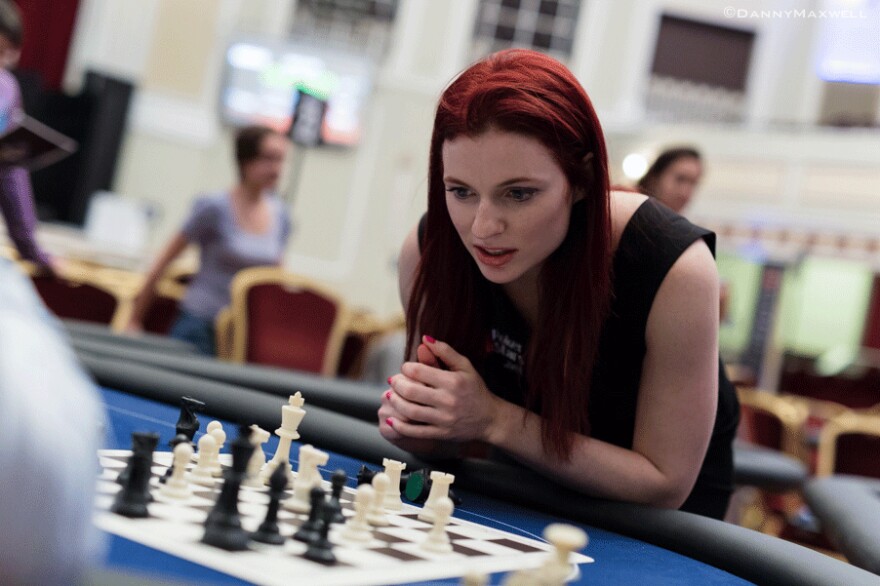My passion for chess began with chess problems. Compositions, as they are also known, are created from scratch to highlight beautiful checkmates and ideas. They help make us stronger chess players, while never pretending toward educational purposes.
For instance, look at this mate in two, by the well-known female composer, Edith Baird, who created hundreds of problems during the late 19th and early 20th centuries.
The creative act of composition was an end in itself for Baird. As she wrote in her book “Seven Hundred Chess Problems Selected from the Compositions of Mrs. W.J. Baird” (1902), “The fascination of composing has always been far greater to me than that of solving.”
In my book, “Play Like A Girl: Tactics by 9 Queens” (2011), I showcased checkmates and tricky tactics by top female champions to instill in young women that “playing like a girl” is a positive thing. Ladies’ Knight: A Female Perspective on Chess – now at the World Chess Hall of Fame -- is the artistic version of that effort, highlighting the important voice of women in chess culture through its display of works that transcend gender and even chess.
The impact of women in chess goes beyond rankings and championships, and yet to overstate that runs the risk of reinforcing a pernicious back-handed compliment of which I have heard plenty of variations: Women are too reasonable to play chess. Many of the pieces in Ladies’ Knight confront this dilemma head-on.
Rachel Whiteread’s “Modern Chess set” reminds me of the false dichotomy between domesticity and intellectualism. Much bloodshed over the chess board is done in privacy these days, in online games or in preparation for over-the-board games using databases. Brilliant moves that are prepared during the off season at a grandmaster’s laptop are referred to as “home-cooking.”
Yoko Ono’s “Play it By Trust” is the ultimate example of the tension between aesthetics and competition. It is a visually appealing takedown of chess as a war metaphor, but also a playable set that emphasizes skill even more than a two-toned set. A strong player will remember to whom each white piece belongs. While doing so, she will be compelled to find a heightened focus, as in the popular exhibition format, “blindfold chess.”
Proficient blindfold players can even play multiple games at once without looking at the board. Four-time U.S. Women’s Chess Champion Anna Zatonskih has given numerous blindfold simultaneous exhibitions in Saint Louis to promote events at the World Chess Hall of Fame and the Chess Club and Scholastic Center of Saint Louis.
I recently gave my first blindfold exhibition in Toronto in conjunction with the ChessBard, a program that converts chess games into poems. My brain had never felt so drained after just one hour. I also felt there was something very feminine about blindfold chess, in its theatrical and meditative nature.
One woman who I interviewed for my first book, “Chess Bitch: Women in the Ultimate Intellectual Sport” (2005), said that she was jealous of her boyfriend, who also played chess professionally, because he was more obsessive about the game than she was. This drive toward obsession in chess has always intrigued me. Some top players, such as World Chess Champion Magnus Carlsen, are models of a more balanced life that allows for sport and socializing as well as intense periods of chess training. Daniela Raytchev portrays various addictions in her set, from eating disorders to gambling. These potential poisons are depicted on pieces that can provide solace from addiction or become addictions in themselves.

In my performance piece, “Naked Chess” (2009), Daniel Meirom and I flipped the iconic image of Marcel Duchamp playing chess against a naked woman, Eva Babitz. The pieces are nude sculptures, and I am playing against a tattooed young man. The viewer observes the scene through my eyes, watching the man as well as the nudes, flipping the male gaze in a way that surely would have pleased Duchamp’s female alter-ego, Rrose Sélavy.
Welcome to Ladies’ Knight, where women look at chess, rather than the other way around.
“Ladies’ Knight: A Female Perspective in Chess” will be at the World Chess Hall of Fame Oct. 29, 2015 - April 17, 2016. For more information, visit www.worldchesshof.org/exhibitions/exhibit/ladiesknight/.
Jennifer Shahade is a chess champion, author, commentator and poker player. She is a two-time American Women’s Chess Champion and the editor at U.S. Chess. Shahade continues to explore the connections between chess and culture as a board member of the World Chess Hall of Fame.




